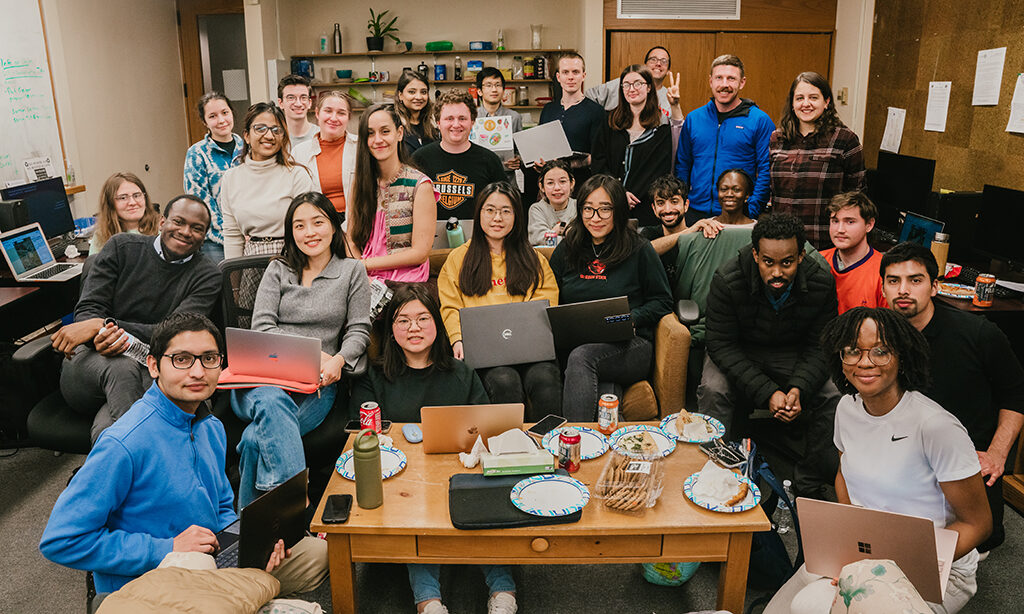Students harness GIS technology to help with earthquake recovery efforts in Turkey and Syria

The horrific scenes emerging from the Feb. 6 earthquake that ravaged parts of Turkey and Syria left millions worldwide feeling powerless to help. Other than donating to a relief fund, what possible assistance could be provided from thousands of miles away?
On Monday night, 30 Clark University students gathered in the Jefferson GIS lab to answer that question.
The students staged a mapathon, using GIS (geographic information systems) technology to convert satellite imagery into maps showing the location of roads, buildings, bridges, and other features in the earthquake-impacted areas to aid relief organizations in their search-and-recovery efforts.
The mapathon was organized by Claudia Buszta and André de Oliveira Domingues, who are master’s students in the GIS program coordinated by the Department of International Development, Community, and Environment and the Graduate School of Geography. The departments co-sponsored the event, providing funding for the evening’s food.
Monday’s mapathon turnout represented a mix of undergraduate, master’s, and doctoral students from various majors. No previous GIS experience was needed to do the mapping: de Oliveira Domingues and Buszta circulated among the participants to offer technical assistance, such as helping to identify the structures that show up as shadows and shapes in the satellite pictures.
“It was encouraging to see how enthusiastic people were about this project,” de Oliveira Domingues said. “The terrifying news of yet another strong earthquake hitting the same region [on Feb. 20] reinforced for us the importance of contributing to the response effort.”
Geography Professor John Rogan noted in an interview just prior to the event that the mapping response is being coordinated worldwide through Humanitarian Open Street Maps, an ongoing project to make digitized, high-resolution maps — similar to those you’d find on Google Earth — available for public use, including by relief agencies, from the Red Cross to the United Nations. He said it’s valuable for those responding to the Turkey/Syria sites to have information on what roads and buildings exist in the affected areas (some of those structures may have been fragmented or collapsed) as they assess the conditions on the ground and plot their disaster-response strategies.
According to de Oliveira Domingues, Clark students learned about the need for crowd-sourced mapping assistance from Corey Dickinson ’15, who is a consultant with the International Federation of Red Cross and Red Crescent Societies in Ankara, Turkey.
“Andre put out a message in a group chat that there was mapping online if people wanted to spread the word about it, and I suggested maybe we should put together a mapathon to bring in more people,” Buszta recalled.
She said the mapathon participants looked for particular features in the satellite images, such as clusters of squares that may be identified as a neighborhood and major roadways that can be used for emergency services vehicles. When they had completed a certain map segment, the students then uploaded the information, which was analyzed and verified by mappers working with one of the coordinating groups.
De Oliveira Domingues compared the student-produced maps to what one might find on Google Maps. “Essentially, we’re taking the satellite view of an area and making it the street view,” he said. “We’re drawing lines where the roads are, and polygons or squares for buildings, to make it easier for people to search and find locations. A lot of the areas we deal with are undermapped for any number of reasons — maybe because they’re rural regions or have been under conflict.”
At the time of this writing, de Oliveira Domingues and Buszta did not have the hard data of how much territory had been mapped on Monday night, but Rogan expects that the student team “created hundreds if not more data points” that will be key to relief and recovery efforts now and deep into the future.
“The geographic scope of these events is so enormous that it’s tough to keep up with, but if important information is generated it will be used by the U.N., by the Red Cross, Red Crescent, and others as they move forward,” he said. “It’s truthful to say that the Clark students’ work will go directly to help plan for the next weeks, months, and perhaps years. This is a really cool thing.”
The mapathon may even have opened the door to similar efforts in the future.
“We were blown away by the turnout, and it was so encouraging to see our community come together and support an important cause,” Buszta said. “Many of the students that I talked to said that they are likely to participate in more online projects on their own, now that they know how to use the platform.”


